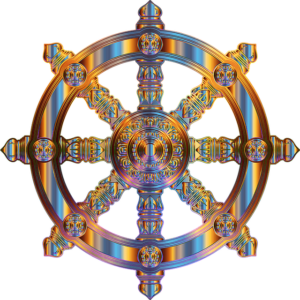Uncover the world of spiritual symbology and find deeper meaning in the top 32 spiritual symbols from various cultures and traditions. Discover their history, significance, and how they can inspire your spiritual journey.
Key Takeaways:
- Spiritual symbols are powerful tools for communication, self-expression, and fostering spiritual growth across cultures.
- Studying spiritual symbols can lead to greater self-awareness, personal growth, unity, empathy, and a broader perspective on life.
- Common themes like interconnectedness, the eternal soul, cycles of life, and the balance of opposites are reflected across symbols from different traditions.
- Incorporating symbolic meanings into one’s spiritual practice can deepen divine connection.
- Spiritual symbols enhance creativity and inspire through their beauty and symbolic significance.
The Power and Importance of Spiritual Symbols
Spiritual symbols have played a vital role in human history, transcending cultural, geographical, and temporal boundaries.
They serve as powerful tools for communication, self-expression, and spiritual growth, as well as a means of connecting with the divine and the collective unconscious.
By understanding and embracing the power of spiritual symbols, individuals can tap into the universal wisdom, energy, and interconnectedness of all things, leading to a deeper sense of meaning and purpose in life.
How Understanding These Symbols Can Enrich Your Life
Developing a deeper understanding of spiritual symbols can have a profound impact on one’s life, opening the door to personal growth, self-discovery, and spiritual transformation. By studying the meanings, history, and cultural significance of various spiritual symbols, individuals can:
- Enhance their spiritual practice: Incorporating spiritual symbols into one’s daily life or meditation practice can serve as a powerful reminder of the divine and the eternal nature of existence, helping to deepen one’s spiritual connection and enhance their overall well-being.
- Foster a sense of unity and connection: Understanding the common themes and elements shared by spiritual symbols from different traditions can foster a sense of unity and connection among people from diverse backgrounds, promoting tolerance, compassion, and empathy.
- Encourage personal growth and self-discovery: Exploring the meanings and significance of spiritual symbols can serve as a catalyst for personal growth and self-discovery, helping individuals to gain a deeper understanding of themselves, their values, and their place in the world.
- Develop a broader perspective: By studying the spiritual symbols of various traditions, individuals can gain a broader perspective on the human experience, recognizing the interconnectedness of all things and the importance of embracing diversity and open-mindedness.
- Enhance creativity and self-expression: Spiritual symbols can serve as a source of inspiration and a means of self-expression, allowing individuals to explore their unique spiritual beliefs and experiences in a creative and meaningful way.
Top 32 Spiritual Symbols and Their Meanings:
1. Om/Aum (Hinduism, Buddhism)
Om or Aum is a sacred sound and symbol in Hinduism, Buddhism, and Jainism, representing the universe and ultimate reality. It is often chanted during meditation or yoga practice, and it signifies the essence of consciousness. The three syllables (A, U, and M) represent the three realms of existence: the physical, astral, and causal planes. Om is believed to connect us to the divine, as well as encompass the past, present, and future.

2. Lotus (Buddhism, Hinduism)
The lotus flower is a symbol of purity, enlightenment, and spiritual growth in both Buddhism and Hinduism. It represents the ability to rise above the murkiness of worldly suffering and ignorance. The lotus flower grows in muddy water, yet remains unstained and beautiful, symbolizing the human soul’s journey to transcend the material world and attain spiritual enlightenment.

3. Yin and Yang (Taoism)
The yin and yang symbol is a fundamental concept in Taoist philosophy, representing the balance and interdependence of opposing forces in the universe. Yin (the dark side) represents femininity, passivity, and receptivity, while yang (the light side) symbolizes masculinity, activity, and creativity. The symbol illustrates the harmony and unity that exists between these two forces, reminding us of the natural cycles of life and the importance of finding balance in our lives.
4. Mandala (Buddhism, Hinduism)
Mandalas are intricate geometric designs that represent the universe, the cosmos, and the self in Hinduism and Buddhism. They are used as meditation tools to help individuals focus their minds, calm their thoughts, and achieve spiritual enlightenment. The intricate patterns and shapes in a mandala symbolize the interconnectedness of all living beings, the impermanence of life, and the cyclical nature of existence.
5. Hamsa (Judaism, Islam)
The Hamsa, also known as the Hand of Fatima or Hand of Miriam, is a protective amulet in Jewish and Islamic cultures. It represents the hand of God and is believed to bring its wearer protection from the evil eye, bad luck, and harm. The five fingers of the Hamsa symbolize the five pillars of Islam or the five books of the Torah, while the eye in the center represents divine watchfulness and protection.

6. Eye of Horus (Ancient Egypt)
The Eye of Horus, also known as the Wadjet, is an ancient Egyptian symbol of protection, power, and good health. It represents the eye of the falcon-headed god Horus, who was associated with the sky, sun, and moon. The Eye of Horus was often used in amulets and talismans to protect the wearer from illness, accidents, and evil forces. It is also a symbol of regeneration and healing, reflecting the myth of Horus and his battle with the god Set.

7. Ankh (Ancient Egypt)
The ankh is an ancient Egyptian symbol that represents eternal life, rebirth, and the union of opposites. It is often depicted in the hands of gods and goddesses, symbolizing their power to grant life and the continuation of the divine cycle. The ankh’s loop represents the eternal soul, while the cross below it signifies the physical plane of existence. The ankh is a reminder of the interconnection between life and death, as well as the possibility of spiritual transcendence.

8. Tree of Life (various cultures)
The Tree of Life is a universal symbol that can be found in various cultures and spiritual traditions, representing the interconnectedness of all life, wisdom, and growth. It often symbolizes the cosmic order, the flow of energy between the heavens and the earth, and the bridge between the physical and spiritual realms. The roots of the Tree of Life represent our deep connection to the earth, while the branches reach towards the sky, signifying our aspiration for higher consciousness and spiritual growth.
9. Dharmachakra (Buddhism)
The Dharmachakra, or Wheel of Dharma, is a Buddhist symbol representing the teachings of the Buddha and the path to enlightenment. The wheel’s eight spokes represent the Noble Eightfold Path, which outlines the principles of right understanding, thought, speech, action, livelihood, effort, mindfulness, and concentration. The Dharmachakra is a reminder of the continuous cycle of spiritual growth and the importance of following the Buddha’s teachings to achieve liberation from suffering.

10. Cross (Christianity)
The cross is the most recognizable symbol of Christianity, representing the sacrifice of Jesus Christ and the redemption of humanity. It symbolizes the intersection of the divine and the human, as well as the eternal love and compassion of God. The cross is a powerful reminder of the transformative power of faith, forgiveness, and spiritual rebirth, encouraging Christians to live in accordance with the teachings of Jesus.
11. Star of David (Judaism)
The Star of David, or Magen David, is a hexagram symbolizing the connection between God and the Jewish people. It consists of two interlocking triangles, representing the balance between the divine and the earthly, as well as the union of opposites. The Star of David has become the emblem of Judaism and the Jewish identity, symbolizing the eternal bond between God and His chosen people.

12. Crescent Moon and Star (Islam)
The crescent moon and star is a widely recognized symbol of Islam, although it is not an official emblem. It represents the divine guidance of Allah, as well as the importance of following the teachings of the Prophet Muhammad. The crescent moon symbolizes the Islamic lunar calendar and the cycles of life, while the star signifies the light of divine truth that illuminates the path of spiritual growth and submission to Allah’s will.

13. Pentacle/Pentagram (Wicca, Paganism)
The pentacle or pentagram is a five-pointed star enclosed in a circle, representing the unity of the elements (earth, air, fire, water) and spirit. In Wicca and other pagan traditions, the pentacle is a symbol of protection, balance, and the connection to the natural world. The five points of the star symbolize the stages of human life, and the circle represents the cyclical nature of existence and the interconnectedness of all things.

14. Triquetra (Celtic)
The triquetra, also known as the Trinity Knot, is a Celtic symbol consisting of three interlocked loops, representing the interconnectedness of life and the unity of mind, body, and spirit. It is often associated with the Holy Trinity in Christianity, as well as the triple goddess in pagan and Wiccan traditions. The triquetra is a powerful symbol of balance, eternity, and the interconnectedness of all aspects of existence.
15. Labyrinth (Greek Mythology)
The labyrinth is an ancient symbol found in various cultures, representing the journey of self-discovery and spiritual growth. In Greek mythology, the labyrinth was an intricate maze designed by Daedalus to hold the Minotaur, a creature with the body of a man and the head of a bull. The labyrinth symbolizes the complexity of the human psyche and the challenges we face as we navigate the twists and turns of life. It serves as a reminder of the importance of introspection and perseverance on the path to self-awareness and enlightenment.

16. Phoenix (Greek Mythology)
The phoenix is a mythical bird that symbolizes renewal, resurrection, and transformation. In Greek mythology, the phoenix is said to live for hundreds of years before being consumed by flames, only to rise again from its ashes, more powerful and radiant than before. The phoenix represents the cycle of death and rebirth, as well as the ability to overcome adversity and emerge stronger and wiser. It is a powerful symbol of hope, resilience, and the enduring nature of the human spirit.

17. Ichthys (Christianity)
The Ichthys, also known as the “Jesus fish” or “sign of the fish,” is an early Christian symbol representing the followers of Jesus Christ. The Greek word “ichthys” (ἰχθύς) is an acronym for “Ἰησοῦς Χριστός, Θεοῦ Υἱός, Σωτήρ” (Iesous Christos, Theou Yios, Soter), which translates to “Jesus Christ, Son of God, Savior.” The Ichthys symbolizes the central tenets of the Christian faith and serves as a reminder of the importance of following Jesus’ teachings and spreading his message of love and salvation.

18. The Swastika (Buddhism, Hinduism)
The swastika is an ancient symbol of good fortune, auspiciousness, and spirituality, found in Hinduism, Buddhism, and Jainism. It represents the eternal nature of the soul and the cyclical nature of existence, with the four arms symbolizing the four directions, the four elements, and the four stages of life. In Hinduism, the swastika is associated with the god Ganesha, the remover of obstacles and the lord of beginnings. Although the swastika has been tarnished by its association with Nazism, it remains an important and sacred symbol in many Eastern religions.

19. Sri Yantra (Hinduism)
The Sri Yantra is a complex geometric diagram used in Hinduism, representing the cosmos and the union of the divine feminine (Shakti) and divine masculine (Shiva) energies. It consists of nine interlocking triangles, with the central triangle representing the goddess Tripura Sundari, the embodiment of pure consciousness and creative power. The Sri Yantra is a powerful meditation tool, believed to bring spiritual transformation, inner peace, and the realization of one’s true nature.

20. Ganesha (Hinduism)
Ganesha is a popular Hindu deity, easily recognized by his elephant head and human body. He is the god of wisdom, knowledge, and new beginnings, as well as the remover of obstacles. Ganesha is often invoked at the start of new projects, journeys, or endeavors, as he is believed to help clear the path to success and bring good fortune. His unique appearance symbolizes the unity of the human and divine realms, as well as the importance of overcoming physical and spiritual obstacles on the path to enlightenment.

21. Viking Runes (Norse Mythology)
Viking runes are the characters of the ancient runic alphabets used by the Germanic and Nordic tribes. Each rune symbolizes a specific concept, power, or element, and they were often used for divination, protection, and magical purposes. Runes were believed to hold immense power and were carved into amulets, weapons, and stones to imbue them with the energy of the corresponding rune. The runes serve as a connection to the wisdom of the ancient Norse gods and the forces of nature, as well as a reminder of the deep spiritual heritage of the Nordic people.
22. Ouroboros (Ancient Egypt, Greek Mythology)
The Ouroboros is an ancient symbol depicting a serpent or dragon eating its own tail, representing the cyclical nature of existence, eternal renewal, and the unity of all things. Originating in ancient Egypt and adopted by Greek philosophers, the Ouroboros symbolizes the continuous cycle of birth, death, and rebirth, as well as the balance between opposing forces in the universe. It is a powerful reminder of the interconnectedness of all things and the eternal nature of the human spirit.

23. Medicine Wheel (Native American)
The Medicine Wheel is a sacred symbol in Native American spirituality, representing the cycles of life, the interconnectedness of all things, and the balance between the physical and spiritual realms. The wheel is divided into four quadrants, each representing a direction, an element, a season, and a stage of life. The Medicine Wheel serves as a tool for healing, self-discovery, and spiritual growth, guiding individuals on their journey to find harmony and balance within themselves and the world around them.

24. Dreamcatcher (Native American)
The dreamcatcher is a Native American symbol believed to protect against negative energy and bad dreams. Traditionally made from a hoop, net or web, and adorned with feathers and beads, dreamcatchers were hung above the sleeping area to filter out nightmares and allow only positive dreams to pass through. The dreamcatcher symbolizes the power of intention, protection, and the importance of maintaining a strong connection to one’s spiritual beliefs and ancestral heritage.

25. Mjölnir (Norse Mythology)
Mjölnir is the legendary hammer of Thor, the Norse god of thunder, representing power, protection, and divine authority. The hammer was said to be so powerful that it could level mountains and slay giants with a single blow. Mjölnir is a symbol of strength, courage, and resilience in the face of adversity, reminding us of the powerful forces within ourselves and the protective energies of the divine.
26. Caduceus (Greek Mythology)
The Caduceus is a symbol featuring two snakes intertwined around a staff, topped with wings. It is often associated with the Greek god Hermes, the messenger of the gods, and the Roman god Mercury. Although frequently mistaken for the Rod of Asclepius, the symbol of medicine and healing, the Caduceus represents wisdom, communication, and the balance between opposing forces. It is a reminder of the importance of seeking knowledge, maintaining balance in our lives, and staying connected to our spiritual nature.

27. Triskele (Celtic)
The triskele, also known as the triskelion or triple spiral, is a Celtic symbol consisting of three interlocking spirals, representing the interconnectedness of life and the unity of mind, body, and spirit. The triskele is often associated with the concept of continuous movement, cycles of growth and change, and the eternal nature of existence. It is a powerful symbol of balance, transformation, and the dynamic flow of energy between the physical and spiritual realms.

28. Infinity (various cultures)
The infinity symbol, also known as the lemniscate, is a mathematical symbol representing the concept of infinity, or something without limits or boundaries. In spirituality, the infinity symbol represents the eternal nature of the soul, the interconnectedness of all things, and the boundless potential within each individual. It serves as a reminder of the infinite possibilities that exist within us and the limitless nature of the universe.
29. Turkish Eye (Turkey)
The Turkish Eye, a spiritual symbol prevalent in Turkey and surrounding regions, represents protection against the evil eye, believed to bring misfortune through malevolent gazes. This amulet, often crafted from glass with concentric blue circles, is thought to provide a shield against negative energy and jealousy. As a symbol transcending cultural boundaries, the Turkish Eye highlights the shared human belief in unseen forces and the power of symbols in safeguarding one’s well-being.

30. Spiral (various cultures)
The spiral is a universal symbol found in various cultures and spiritual traditions, representing the cycles of life, growth, and transformation. In ancient Celtic culture, the spiral symbolized the ever-changing nature of existence and the continuous flow of energy between the physical and spiritual realms. In Native American spirituality, the spiral represents the journey of self-discovery, personal growth, and the interconnectedness of all things. The spiral is a powerful reminder of the cyclical nature of life and the importance of embracing change and growth on the path to spiritual enlightenment.

31. Torii Gate (Shintoism)
The Torii Gate is a traditional Japanese gate found at the entrance of Shinto shrines, representing the boundary between the physical and spiritual worlds. The gate symbolizes the transition from the mundane to the sacred and serves as a reminder of the importance of respecting and honoring the divine in all aspects of life. The Torii Gate is a powerful symbol of the interconnectedness of the physical and spiritual realms and the ever-present nature of the divine in our lives.

32. White Buffalo (Native American)
The White Buffalo is a sacred symbol in many Native American cultures, representing abundance, prosperity, and the fulfillment of prophecy. The White Buffalo is believed to be a messenger from the Great Spirit, bringing peace, harmony, and balance to the world. The appearance of a White Buffalo is considered a rare and auspicious event, symbolizing the unity of all nations and the potential for positive change on a global scale. The White Buffalo serves as a reminder of the importance of staying connected to our spiritual beliefs, respecting the natural world, and working together to create a better future for all.

Spiritual Symbols and Meanings in Brief:
| Symbol | Tradition | Meaning |
|---|---|---|
| Om/Aum | Hinduism, Buddhism | Represents ultimate reality and universe |
| Lotus | Buddhism, Hinduism | Purity, enlightenment, rising above suffering |
| Yin Yang | Taoism | Balance and interdependence of opposing forces |
| Mandala | Buddhism, Hinduism | Interconnectedness, impermanence, cyclical existence |
| Hamsa | Judaism, Islam | Protection from evil eye and harm |
| Eye of Horus | Ancient Egypt | Protection, health, sun and moon deities |
| Ankh | Ancient Egypt | Eternal life, rebirth, union of opposites |
| Tree of Life | Various cultures | Interconnectedness of life, bridge between realms |
| Dharmachakra | Buddhism | Buddha’s teachings and the Eightfold Path |
| Cross | Christianity | Redemption through Christ’s sacrifice and love |
| Star of David | Judaism | Connection between God and Jewish people |
| Crescent Moon and Star | Islam | Guidance and teachings of Allah and Muhammad |
| Pentacle | Wicca, Paganism | Protection, balance and unity of elements and spirit |
| Triquetra | Celtic | Unity of mind, body and spirit; Holy Trinity |
| Labyrinth | Greek mythology | Journey of self-discovery and spiritual growth |
| Phoenix | Greek mythology | Renewal, rebirth, resurrection |
| Ichthys | Christianity | Jesus Christ as Son of God and Savior |
| Swastika | Hinduism, Buddhism | Good fortune, spirituality, eternal soul |
| Sri Yantra | Hinduism | Union of divine feminine and masculine energies |
| Ganesha | Hinduism | Remover of obstacles, wisdom and new beginnings |
| Viking Runes | Norse mythology | Power, protection, connection to ancient wisdom |
| Ouroboros | Ancient Egypt, Greek mythology | Cyclical nature of existence, unity of all |
| Medicine Wheel | Native American | Cycles of life, balance, interconnectedness |
| Dreamcatcher | Native American | Protection from negative energy and bad dreams |
| Mjölnir | Norse mythology | Power, protection, strength and courage |
| Caduceus | Greek mythology | Wisdom, communication, balance |
| Triskele | Celtic | Interconnectedness, unity, continuous movement |
| Infinity | Various cultures | Eternal soul, boundless potential |
| Turkish Eye | Turkey | Protection against evil eye and misfortune |
| Spiral | Various cultures | Cycles of life, growth, transformation |
| Torii Gate | Shintoism | Boundary between physical and spiritual realms |
| White Buffalo | Native American | Abundance, fulfillment of prophecy, unity |
Q’s & A’s
What are spiritual symbols and why are they important?
A1: Spiritual symbols are visual representations of abstract concepts, beliefs, and values related to spirituality, the divine, and the human experience. They are important because they serve as powerful tools for communication, self-expression, and spiritual growth, as well as a means of connecting with the divine and the collective unconscious.
How can understanding spiritual symbols enhance one’s spiritual practice?
Incorporating spiritual symbols into one’s daily life or meditation practice can serve as a powerful reminder of the divine and the eternal nature of existence, helping to deepen one’s spiritual connection and enhance their overall well-being.
How can exploring spiritual symbols from different traditions foster a sense of unity and connection among people?
Understanding the common themes and elements shared by spiritual symbols from different traditions can foster a sense of unity and connection among people from diverse backgrounds, promoting tolerance, compassion, and empathy.
In what ways can studying spiritual symbols encourage personal growth and self-discovery?
Exploring the meanings and significance of spiritual symbols can serve as a catalyst for personal growth and self-discovery, helping individuals to gain a deeper understanding of themselves, their values, and their place in the world.
How can developing a broader perspective on spiritual symbols from various traditions impact an individual’s worldview?
By studying the spiritual symbols of various traditions, individuals can gain a broader perspective on the human experience, recognizing the interconnectedness of all things and the importance of embracing diversity and open-mindedness.
Can spiritual symbols enhance creativity and self-expression?
Yes, spiritual symbols can serve as a source of inspiration and a means of self-expression, allowing individuals to explore their unique spiritual beliefs and experiences in a creative and meaningful way.
Are there any similarities between spiritual symbols from different traditions?
Yes, many spiritual symbols from different traditions share common themes and elements, reflecting the universal search for meaning, connection, and transcendence that unites all human beings.
Conclusion
The rich tapestry of spiritual symbols that can be found across various cultures and traditions highlights the universality of the human quest for meaning, connection, and protection.
By exploring and understanding the top 32 spiritual symbols and their meanings, we can gain valuable insights into the diverse belief systems that shape our world and foster a deeper appreciation for the shared human experience.
These spiritual symbols serve as powerful reminders of the interconnectedness of all things, the eternal nature of existence, and the importance of embracing our own spiritual path.
As we journey through life, these symbols can inspire us to seek balance, personal growth, and a deeper connection with the divine, enriching our lives and fostering a greater sense of unity among people from all walks of life.
See also:
35 Inspiring Symbols of Growth: Unleash Your Inner Potential
Ancient Protection Symbols from Around the World
32 Symbols of Rebirth: Inspiring Signs of Change and Growth
30 Powerful Symbols of Resilience from Across the Globe: Norse, Celtic, and Beyond











